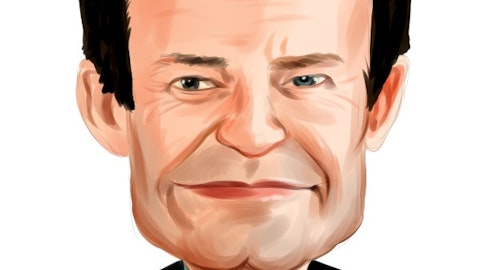Keysight Technologies, Inc. (NYSE:KEYS) Q1 2023 Earnings Call Transcript February 21, 2023
Operator: Good day, ladies and gentlemen, and welcome to the Keysight Technologies Fiscal First Quarter 2023 Earnings Conference Call. My name is Jason, and I’ll be your lead operator today. After the presentation, we will conduct a question-and-answer session. This call is being recorded today, Tuesday, February 21, 2023 at 1:30 p.m. Pacific Time. I would now like to hand the conference over to our host, Jason Kary, Vice President, Treasurer and Investor Relations. Please go ahead.
Jason Kary: Thank you, and welcome everyone to Keysight’s first quarter earnings conference call for fiscal year 2023. Joining me are Keysight’s President and CEO, Satish Dhanasekaran, and our CFO, Neil Dougherty. In the Q&A session we will be joined by Senior Vice President of Global Sales and Chief Customer Officer, Mark Wallace. The press release and information to supplement today’s discussion are on our website at investor.keysight.com under the financial information tab and quarterly reports. Today’s comments will refer to non-GAAP financial measures. We will also make reference to €œcore€ growth, which excludes the impact of currency movements and acquisitions, or divestitures completed within the last 12 months.
The most directly comparable GAAP financial metrics and reconciliations are on our website, and all comparisons are on a year-over-year basis unless otherwise noted. We will make forward-looking statements about the financial performance of the Company on today’s call. These statements are subject to risks and uncertainties and are only valid as of today. We assume no obligation to update them. Please review our recent SEC filings for a more complete picture of these risks and other factors. As a reminder, we are hosting our 2023 Investor Day on March 7th at the New York Stock Exchange. Management is also scheduled to participate in the Morgan Stanley Investor Conference on March 8th. And now, I’ll turn the call over to Satish.
Satish Dhanasekaran: Thank you, Jason. Good afternoon, everyone and thank you for joining us today. Keysight delivered exceptional first quarter financial results, posting revenue and earnings above the high end of our guidance against a backdrop of moderating demand. Our performance and consistent execution demonstrate the resilience of our business, and despite the challenging macro dynamics, we believe Keysight is well-positioned to build on our success and expand our leadership across our end-markets. I’ll focus my comments today on three key headlines. First, we achieved strong financial results. Revenue was a first quarter record and grew 14% on a core basis, driven by strength in both business segments and across all geographies.
We again demonstrated the durability of our financial model and delivered $2.02 in earnings per share. Second, we started to see a normalization of what has been a robust and prolonged period of investment by our customers. Over the past two years, significant demand for Keysight’s solutions resulted in a 15% compound order growth rate and a book-to-bill of 1.09. As demand slows in the near-term, Keysight’s exposure to multiple end markets, its differentiated portfolio, and our strong operating discipline positions us well to weather the current macro dynamics. Third, we remain confident in the secular, long-term growth trends across our markets. Our software-centric solutions strategy is well-aligned with the needs of our customers, which we expect will enable us to outperform the market.
We look forward to providing you a more comprehensive update on our long-term growth strategies and financial objectives at our upcoming Investor Day. Now let’s take a deeper look at our first quarter results. Orders declined 13% year-over-year against a strong compare of 22% growth in the last year’s first quarter. The slowing demand and business specific headwinds that we anticipated last quarter materialized largely as expected. These included the year-over-year impact of currency, our exit of Russia, and incremental China trade sanctions, which together contributed to a 6-point drag on the compare. We saw customers exercise caution in response to macroeconomic uncertainty. This was most notable among our largest customers in Commercial Communications, who were impacted by sharp demand decline in consumer electronics and computing segments.
They are restructuring and reassessing their near-term priorities as the industry digests inventory, while at the same time maintaining investments across key, strategic programs. While the duration is difficult to predict, we expect these dynamics to weigh on our customers for at least the next couple of quarters. Despite macro challenges, revenue grew 10%, or 14% on a core basis. Strong execution and operational discipline resulted in gross margin of 65%, operating margin of 30%, and earnings per share growth of 22%. Turning to our business segments. The Electronics Industrial Solutions Group revenue grew 19% and delivered double-digit revenue growth for the 10th consecutive quarter, which underscores the diversity of our industry exposure.
In automotive, we achieved record revenue and strong double-digit growth across all regions. Sales of electric vehicles continued to grow significantly in 2022, further fueling investment in EV and AV technologies and manufacturing. This quarter we secured multiple strategic wins with large OEMS and Tier 1 suppliers across a breadth of applications such as 5G, autonomous driving emulation, battery and charging infrastructure design, and in-vehicle networks. To strengthen our position in this market and capitalize on this growing, decades-long opportunity, we continue to expand our portfolio of solutions. An example is our current collaboration with Jiyun Technologies to develop a high-efficiency, compact battery test system to help accelerate the launch of new electric vehicles.
In general electronics, double-digit revenue growth was driven by continued strength in emerging verticals such as digital health and IoT. We also secured wins in advanced research, as R&D investment remains robust in quantum, photonics, and Beyond 5G. Semiconductor solutions revenue growth was driven by continued fab investments in new wafer capacity and advanced nodes. While the inventory adjustments are pacing demand, foundries continue to execute their longer-term plans to globalize their production. We see significant opportunities in this market, and are investing in solutions for emerging semiconductor applications such as silicon photonics, high-power semis, and millimeter wave. Turning to our Communications Solutions Group, revenue grew 7%, with growth across both end markets and all regions.
Commercial Communications revenue grew 11% on a core basis, to reach a record Q1, which was driven by ongoing, strategic investments in communications ecosystem. We saw strength in 5G R&D and deployments, Open-RAN, and datacenter networking, with increased focus on 800 gigabit and terabit communications solutions. These programs remain a priority and are driving demand for Keysight’s first-to-market solutions. As a trusted advisor, we remain actively engaged with our customers as they adapt to the current macro environment. We recently announced our collaboration with Qualcomm to accelerate 5G non-terrestrial network communications for broadband in remote areas, and enable device makers to speed development and verification of 3GPP Release 17 compliant designs.
We continued to support the progression of standards and submitted the first 3GPP Release 16 protocol conformance test, enabling new use cases such as private and industrial networks, and autonomous vehicles. Investment in early 6G research is underway and Keysight joined forces with 16 organizations to create 6G-SANDBOX, a pan-European testbed for 6G experimentation and validation of 5G-Advanced and 6G capabilities. Nokia recently selected Keysight’s sub-Terahertz testbed to validate D band and E band technology to accelerate R&D critical to 5G-Advanced and 6G use cases in millimeter wave and sub-terahertz frequency spectrum. We also announced industry’s first and highest density network cybersecurity test platform, which provides data center network infrastructure and cloud providers with leading 400 gigabit Ethernet security validation capabilities.
These solutions reinforce our leadership across wireless and wireline ecosystems. We are also looking forward to Mobile World Congress in Barcelona next week. Keysight will be engaged with many customers and industry leaders, and showcasing our solutions for advancing 5G standards including Release 17 and early research in 6G and intelligent automation. Turning to our government, defense, and aerospace business, record Q1 revenue grew 9% on a core basis, achieving its second highest revenue quarter driven by increased U.S. government spending, and strength in space and satellite, including new applications for non-terrestrial networks. We recently won a five-year contract with the U.S. Army who chose Keysight’s Field Fox handheld spectrum analyzer for field use.
We expect U.S. government budget appropriations to ramp spending in new programs in the second half of this year. We also anticipate an increase in defense budgets worldwide, and growing investment in new technologies such as 5G, space and satellite, quantum, and advanced research. Consistent with our strategy, we continue to expand our software capabilities. We recently completed the acquisition of Cliosoft, whose data and IP management software tools enhance our portfolio of electronic design automation solutions. In addition, Eggplant’s test automation platform was recently recognized as a leader by The Forrester Wave. About one-third of total revenue, the growing mix of software and services is integral to the durability of our financial model.
Keysight’s differentiation is a function of our software-centric solutions strategy, collaboration with our customers, and investments we are making to ensure that we address the most challenging technology needs of today, and into the future. We are prioritizing high-conviction growth opportunities to solidify our competitive position for the long-term, while at the same time accelerating initiatives to drive further efficiencies consistent with our financial model. We remain committed to creating long-term value for business stakeholders, and positively impacting the global community. I’m proud that Keysight has been named to the Dow Jones Sustainability Index for the fourth year in a row. I’d like to thank all our Keysight employees for their dedication and relentless execution, which drives our strong track record of performance and is a testament to Keysight’s Leadership Model, our values, and to our people.
With that, I’ll now turn the call over to Neil to discuss our financial performance and outlook.

Neil Dougherty: Thank you, Satish, and hello, everyone. Q1 was a strong quarter and a solid start to the year. We delivered revenue of $1,381 million, which was above the high end of our guidance range, and grew 10%, or 14% on a core basis. As we anticipated, macroeconomic uncertainty moderated demand in the first quarter. Orders of $1.3 billion were down 13%, or 10% on a core basis. Even with revenue outpacing orders by $80 million, we ended the quarter with over $2.5 billion in backlog. Turning to our operational results for Q1, we reported gross margin of 65% and operating expenses of $492 million, resulting in operating margin of 30%. We achieved net income of $363 million and delivered $2.02 in earnings per share, which was above the high-end of our guidance.
Our weighted average share count for the quarter was 180 million shares. Moving to the performance of our segments, our Communications Solutions Group generated revenue of $939 million, up 7%, or 10% on a core basis. Commercial Communications revenue of $629 million was up 8%, with double-digit revenue growth in the Americas. Aerospace, defense and government revenue of $310 million benefited from increased U.S. government spending, which we believe will continue to ramp through FY23. Altogether, CSG delivered record gross margin of 67%, and operating margin of 29%. The Electronic Industrial Solutions Group generated first quarter revenue of $442 million, up 19%, or 23% on a core basis, with double-digit revenue growth in automotive and general electronics, demonstrating the diversity of our markets.
Growth was strongest in the Americas and Europe. EISG reported gross margin of 61%, and operating margin of 32%. Moving to the balance sheet and cash flow. We ended our first quarter with $2.2 billion in cash and cash equivalents, generating cash flow from operations of $366 million, and free cash flow of $306 million, or 22% of revenue. Shares repurchases this quarter totaled approximately 700,000 shares at an average share price of $176, for a total consideration of $125 million. Now, turning to our outlook. We’re navigating the same evolving macro and industry dynamics that others have noted. As Satish mentioned, we expect it will take at least a couple of quarters for customers to work through their near-term challenges. If the current demand environment persists through our fourth quarter, we would expect to deliver low single-digit revenue and earnings per share growth for the year, achieved through steady backlog conversion, strong cost discipline, and the flexibility of our financial model.
Turning to our second quarter guidance. We expect revenue to be in the range of $1,370 million to $1,390 million, and Q2 earnings per share to be in the range of $1.91 to $1.97, based on a weighted diluted share count of approximately 179 million shares. While near-term uncertainties are moderating the demand environment, Keysight’s secular, long-term growth trends remain intact. Our differentiated, first-to-market solutions, durability of our financial model, steady cash generation, and strong balance sheet position us well to deliver on our commitments to our customers and shareholders. We look forward to sharing more with you about the compounding nature of our business at our upcoming Investor Day. With that, I will now turn it back to Jason for the Q&A.
Jason Kary: Thanks, Neil. Jason, can you give the instructions for the Q&A, please?
See also 10 Tech Stocks To Sell Now According to Cathie Wood and 12 High Growth Real Estate Stocks that are Profitable.
Q&A Session
Follow Keysight Technologies Inc. (NYSE:KEYS)
Follow Keysight Technologies Inc. (NYSE:KEYS)
Operator: Yes. Our first question is from Mark Delaney with Goldman Sachs.
Mark Delaney: Yes. Good afternoon. Thank you very much for taking the question. I was hoping, first, if you could elaborate a little bit more on the comments on orders. It seems like it’s particularly impacting the Commercial Communications business and maybe certain other areas are doing a bit better. But if you could offer a bit more on where you’re seeing the orders and where perhaps you’re seeing some moderation from customers?
Satish Dhanasekaran: Yes. Hi Mark. What we’ll do — first, I want to start by saying our customer engagements remain very strong, robust shipment activity this quarter, and you see that reflected in the strong revenue performance. Second, our backlog is still at $2.5 billion, high-quality, low cancellations to date. And to put this demand normalization in context, I would just point to two things. First, as we said in the last earnings call, we have some business-specific headwinds, roughly 6 to 7 points, that played out. And this quarter, our comps from a year ago, we were up 22%. So putting those things in context, a little bit more deep dive I’ll provide on the end markets could be helpful. In Commercial Communications, we saw the top customer pull back, especially in the wireless part of the business, due to the macro challenges and the inventory digestion that they were going through, especially with regard to the smartphone industry.
We also saw equally the activity system pickup on the wireline side as customers are investing in 400 gig and 800 gig Ethernet and terabit and beyond. So, those investments remain strong. In our aerospace and defense business, we’re starting to see a favorable uptick in the U.S. business as budgets are passed and program spends get unlocked. It’s also important to note that the — that all of the prime contractors had stronger backlog positions, which also gives us a good outlook as we look ahead. And our Industrial business continues to show resilience with the research spend occurring in different countries around the world, automotive with EV and AV and next-gen semi investments remaining strong as well. So, we put all of this in context and say, we remain confident in the portfolio differentiation we have and we’re actively engaged with our customers, which will enable us to outperform this environment.
Mark Delaney: Thanks, Satish. That’s very helpful. My other question was on the cost controls, and the Company spoke about being disciplined. Were you alluding more to the variable nature of your cost structure, and that will moderate spending depending on what demand ultimately does this year, or are there more specific steps that Keysight is planning to take on cost controls? Thank you.
Satish Dhanasekaran: Yes. Mark, as we mentioned, always that we have this variable cost structure and operating model, that’s the first leg of our resilience from a financial perspective. But we’re always looking for dynamic resource allocation opportunities, especially in a market like this, where we see some of our customers pull back. We redeploy to other customers who need these technologies so that we’re maximizing. So that’s part of that discipline that I referenced. And we always have on deck operational efficiency programs as part of the Keysight leadership model. And we’re remaining focused on that, in some cases, even accelerating that. That should help us offset the inflationary impacts to the P&L as we are all faced with right now.
Operator: Our next question comes from Mehdi Hosseini with SIG.
Mehdi Hosseini: I want to go back to booking a backlog. You guys have been very clear for a couple of quarters that post-COVID we’re going to have to go through a backlog normalization. And I want to get some more color from you is, is there any way you can separate or differentiate the backlog normalization from end market demand weakness, especially in the smartphone area that you highlighted?
Satish Dhanasekaran: Yes. Maybe I’ll just start, and then Neil can add. I’d say that if we look at our end markets and if you take a look at the commercial comps, especially in the wireless side, the top customer pull back is definitely macro related and related to the inventory exposure that they have, which has been widely talked about. But if we look at the base customer spend, it remains pretty strong. So, that’s as far as that end market is concerned, but we start to look at aerospace defense and our industrial exposure, which continues to provide us top line diversity. And I think that will play out as we go through the year as well. Neil, specific to our backlog position?
Neil Dougherty: Yes. I mean, the only thing I would add to that is maybe starting with the supply chain, we still have areas where we are supply chain constrained. But in other areas, we’ve seen a pretty rapid improvement in terms of availability of product and kind of the trend towards normalization of lead times. And so what we are seeing, and I’ve talked about this is something we expected. In many cases, we have products for the — or customers for those products that have scheduled shipments now out an additional quarter and beyond. And as our lead times have come in, they don’t now, at this time, need to place new orders until they get delivery of the product that’s already sitting in backlog. And so, the — if you’re around 6 or 8 months, there was this tendency to place orders early to get in line to adjust for those long lead times.
Now that we’re seeing lead times normalize and coupled with macro uncertainty, there’s no longer that incentive to get in line early and that is creating a little bit of additional pressure on the order line.
Mehdi Hosseini: Sure. And just a follow-up here. You did $1.3 billion of new orders. Is there any way we could think about the R&D portion of that order or the strategic investment that were reflected in the $1.3 billion from production? And I’m just trying to better understand how we should think about the downside risk in booking activity from here? Is there like a — is $800 million a quarter the worst-case scenario, or anything in that nature that you can offer would be very helpful.
Satish Dhanasekaran: Yes. Thank you, Mehdi. Again, it remains a highly uncertain environment as you know. What we’re seeing is customers typically firm up demand and budgets at the beginning of the year because of the concerns they have, they’re pushing out those decisions to later in the year. So, the uncertainty definitely remains. But as we look at the spending environment, especially even in commercial comms, we see more pullback around manufacturing expansions relative to the R&D plans of customers. So that’s generally the trend. And if you look in the ISG business, I’ll say, in the semiconductor as an example, customers are not pulling back on next-gen semi capacity, right, whether it’s 5-nanometer or 3-nanometer, they’re actually maybe cutting back on some of the 7-nanometer work they were planning on.
So, the focus on next generation remains very strong. I may — I will ask Mark to provide some color on the customer dynamics that he’s seeing in the — from a sales perspective.
Mark Wallace: Yes. And I would — Mehdi, I would — just to directly answer your question, the mix during the quarter was still very predominant R&D. And Satish mentioned, the pullback was much less there and especially in commercial comms than it was on the manufacturing side. The other factor that we’ve talked about in the past on other conference calls is our funnel. We have a six-month funnel that gives us a strong indication of the forward-looking demand. That has been factored into our guide. It has normalized with the effects that we saw pretty acutely here in the first quarter. And looking out six months, the demand signal looks to be fairly consistent, in line with what we saw in Q1.





